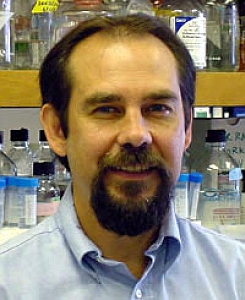In an early-stage clinical trial, researchers at University of North Carolina in Chapel Hill have demonstrated the safety of creating a genetically-engineered virus to treat a form of muscular dystrophy. The findings of pharmacologist Jude Samulski (pictured left) and colleagues are reported online in the journal Molecular Therapy; paid subscription required.
With gene therapy, a patient’s faulty genes are corrected with healthy genes, most often found in natural systems such as viruses for infecting and introducing new genes into cells. Even with this process, there may not be a perfect match for a replacement gene in nature, thus the need at times to engineer the replacement gene.
In this study, Samulski’s team tested the safety of a chimeric virus — one composed of genetically distinct cells — to deliver replacement genes for an essential muscle protein in patients with Duchenne muscular dystrophy. This form of muscular dystrophy usually affects young children and is caused by a defective gene for dystrophin, a protein in the muscles.
To create the most desirable gene therapy virus to deliver the healthy dystrophin gene, the researchers chose the adeno-associated virus or AAV, a non-pathogenic virus to which most humans are exposed. The team took different desirable properties for their delivery virus from different forms of AAV — the ability to infect muscle tissue from one AAV form, and safe track record from another form — and combined them in a hybrid or chimeric virus.
In the first trial of this gene therapy, designed primarily to test for safety and tolerability, the researchers gave the engineered virus containing the healthy gene for dystrophin to six boys with Duchenne muscular dystrophy. The replacement genes were injected into the bicep in one arm and a placebo was injected into the other arm of each of the patients. The researchers were able to detect the new genes in all of the patients treated with the gene therapy, but with no harmful effects on the patients’ immune systems.
Samulski says, the next phase of clinical trials, testing for effectiveness as well as safety, will need careful planning and execution. Delivering enough replacement genes to generate a therapeutic effect could require larger doses of virus, which in turn could elicit an unwanted immune response. The researchers are looking into a new high-pressure technique, also developed at Chapel Hill, to get the virus into muscle at lower doses.
Read more: FDA Gives Muscular Dystrophy Therapy Orphan Drug Status
* * *


 RSS - Posts
RSS - Posts
You must be logged in to post a comment.